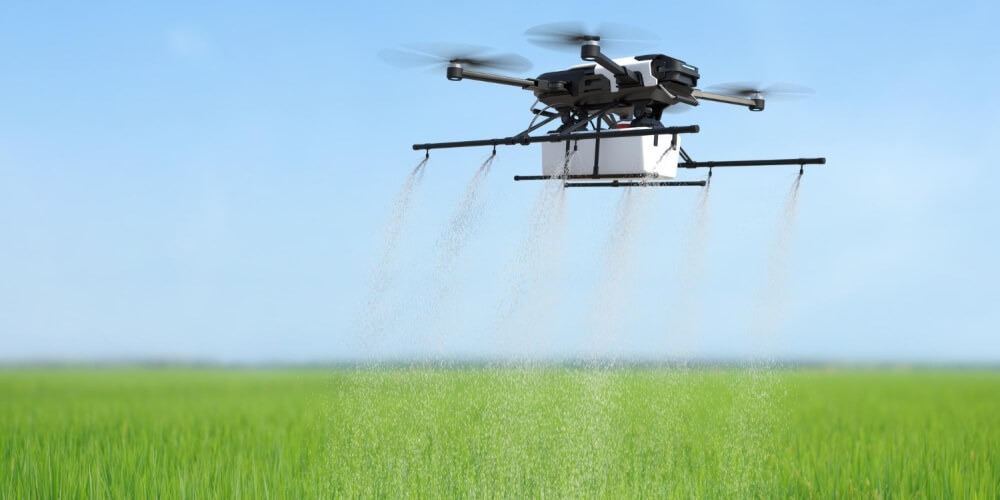
Crop spraying requires more labor work in the traditional spraying methods. Even after spending a lot of time, it can still lead to uneven distribution.
One way to make crop spraying more efficient is by using agricultural drones. These drones are helping farmers to precisely spray fertilizer or pesticides where they are needed rather than focusing on the entire farm.
This is why increasingly many farmers are now switching to agricultural drones for crop spraying. Are you curious to learn more about crop-spraying drones?
Keep reading as we explore more about the agricultural drone benefits as well as the return on investment for small farmers. Let us get started to get to know crop spraying drones in detail!
What Are Crop Spraying Drones?
In simple words, crop spraying drones are like flying machines that make spraying fertilizer or pesticides more precise to increase efficiency.
Agriculture drone spraying is GPS-guided and can be programmed to cover fields with precision. As a result, it reduces chemical waste when compared to the traditional spraying methods.
With the help of these drones, even distribution of fertilizer or pesticides is effortless, even in large farms. What makes them more cool? They are automated!
You can pre-program the flight to these drones to reduce manual effort. As we all know, in hilly terrain, it is difficult to spray fertilizer or pesticides. These agricultural drones make it easy for you to spray evenly across your flat or hilly regions.
Farmers can now reduce chemical exposure as well as enjoy efficiency spraying with agricultural drones!
What is the Cost of Crop Spraying Drones?
The price of a crop spraying drone can vary depending on the size or features. The price range for a basic drone is between ₹3-5 lakhs. The more advanced agricultural drones could cost ₹7-10 lakhs with features like LiDAR sensors or large tank capacities.
For small farmers, investing this high upfront cost could be difficult. Hence, renting crop spraying drones from reliable providers like Leher or exploring government subsidiaries will be beneficial.
There are some ongoing costs to think about in addition to the hefty initial investment. Here are some of them!
-
There could be maintenance or replacement of battery costs for the smooth operations of drones.
-
Farmers require training or certification to operate the drone.
-
Some drones require software updates or subscription fees for automated routes.
Benefits of Crop Spraying Drones for Small Farmers
Precision Agriculture
Crop spraying drones help farmers reduce excessive use of chemicals by spraying fertilizers or pesticides only where they need them. As a result, it leads to efficient chemical applications by lowering costs.
Time Efficiency
The traditional spraying methods using hand sprayers or tractors take a lot of time to spray fertilizer or pesticides for the entire farm. But crop spraying drones can cover even large fields in minutes, which saves more time.
Cost Savings
There is no denying that crop spraying drones save more money when compared to traditional methods. They can lower labor costs as well as reduce chemical wastage.
Improved Crop Health
It is more difficult to spray evenly in the traditional spraying methods. With crop spraying drones, even distribution of fertilizer or pesticides is effortless. This boosts crop health by reducing pest infestations.
Environmental Impact
Crop-spraying drones are the ideal choice for sustainable farming practices. This is because it reduces chemical runoff, which damages the environment significantly.
Safety Benefits
In traditional spraying methods, farmers are at risk of direct exposure to harmful chemicals. With crop spraying drones, farmers can now stay safe from harmful chemicals.
Calculating ROI (Return on Investment) of Crop Spraying Drone
How to Calculate ROI?
Farmers can calculate the ROI to find out whether agricultural spraying drones are worth the cost. Here is a simple formula to calculate the ROI!
ROI = (Net Benefits- Investment Cost) ÷ Investment Cost × 100
Let us make it simple to understand with an example. Consider a farmer investing ₹5 lakhs in a drone. The drone increases the yield by ₹2 lakhs, saves ₹1 lakh in labor, as well as cuts chemical costs by ₹50,000 in a year.
Net Benefits = ₹2,00,000 + ₹1,00,000 + ₹50,000 = ₹3,50,000
ROI = (₹3,50,000- ₹5,00,000) ÷ ₹5,00,000 × 100 = 30% in the first year
As costs drop over time, farmers could recover their investment in 2-3 years!
Factors That Impact ROI
-
Size of the farm! This is because drones can cover large farms more quickly. Hence, it reduces the costs significantly.
-
The frequency of spraying.
-
The type of crop.
-
Usage of the agricultural drone.
Are Crop Spraying Drones Worth It for Small Farmers?
Undoubtedly, crop-spraying drones are worth the investment because of their many benefits. Drones are helpful in precise spraying by reducing environmental damage. For small farmers, the initial investment can be high, but it pays you back with increased yields.
Farmers can also make use of agricultural drone renting options with reliable partners like Leher to increase efficiency without any burden of high initial investment.
Crop-spraying drones are a smart way to increase your yields by reducing costs!